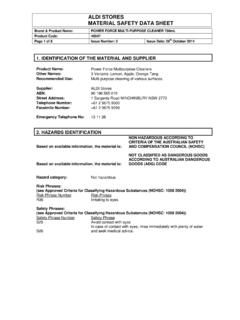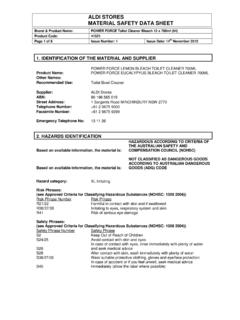Transcription of SAFETY DATA SHEET - ALDI
1 Document No: Date:24-Jul-15 90 196 565 019 Australia - 13 11 26 (Poisons Information Centre)1. IDENTIFICATION OF THE MATERIAL AND SUPPLIER POWER FORCE Anti Bac Plus Disinfectant Spray ORIGINALD isinfectant Names (if applicable) +61 2 9675 9000 Telephone Number2. HAZARDS IDENTIFICATION Dangerous according to Australian Dangerous Goods (ADG) Code, IATA and IMDG/IMSBC classified as hazardous according to the criteria of SWA. 1249 Product Name 1 Sargents Road, MINCHINBURY, NSW 2770 ABNP roduct CodeCompany NameRecommended Use35699 Street AddressBarcode NumberSupplier CodeOther Emergency Phone Number26107615 ALDI stores (A Limited Partnership)Classification of the substance or mixture( According to the WHS Regulations and the ADG Code ) Label elements GHS label Version Number:SDS Version Date: SAFETY data SHEETS ignal WordNone knownH222: Extremely flammable aerosolPrecautionary statement (s)Hazard statement (s)P211: Do not spray on an open flame or other ignition sourceP251: Pressurized container.
2 Do not pierce or burn, even after : Do not get in : Use personal protective equipment as requiredOther hazardsP102: Keep out of reach of : Keep away from heat, sparks, open flames and hot surfaces. - No : Contains gas under pressure; may explode if heatedApproved by: Angela O'SheaCONTROLLED DOCUMENTThis document becomes uncontrolled once 1 of 5 Document No: Version Number:SDS Version Date: SAFETY data SHEETC omponentsCAS NumberProportion3. COMPOSITION / INFORMATION ON INGREDIENTS , C3-468475-59-2 10-30 Ethanol64-17-5>50 Other non hazardous ingredientsvariousto 100 Approved by: Angela O'SheaCONTROLLED DOCUMENTThis document becomes uncontrolled once 2 of 5 Document No: Version Number:SDS Version Date: SAFETY data SHEET Hazards from combustion productsThe major hazard in fires is usually inhalation of heated and toxic or oxygen deficient (or both), fire gases.
3 Precautions for firefighters and special protective equipmentThere is a moderate risk of an explosion from this product if commercial quantities are involved in a fire. Firefighters should take care and appropriate precautions. Recommended personal protective equipment is full fire kit and breathing apparatus. 6. ACCIDENTAL RELEASE MEASURESS uitable / Unsuitable extinguishing materialIn case of fire, use carbon dioxide, dry chemical, foam, water fog. Water fog or fine spray is the preferred medium for large fires. No effects expected. If irritation does occur, flush contaminated eye(s) with lukewarm, gently flowing water for 5 minutes or until the product is removed.
4 Obtain medical advice if irritation becomes painful or lasts more than a few minutes. Take special care if exposed person is wearing contact to PhysicianTreat FIRE FIGHTING MEASURESEye ContactFor advice, contact Poisons Information Centre (phone Australia 13 11 26) or a doctorInhalationSkin Contact First aid is not generally required. If in doubt, contact a Poisons Information Centre or a doctor.(For each route of exposure provide indication of medical attention and special treatment needed including description of most important symptoms, acute and delayed)Ingestion If product is swallowed or gets in mouth, do NOT induce vomiting; wash mouth with water and give some water to drink.
5 If symptoms develop, or if in doubt contact a Poisons Information Centre or a is unlikely. However, if irritation does occur, flush with lukewarm, gently flowing water for 5 minutes or until chemical is FIRST AID MEASURES For minor spills, clean up, rinsing to sewer and put empty container in garbage. Although no special protective clothing is normally necessary because of occasional minor contact with this product, it is good practice to wear impermeable gloves when handling chemical products. In the event of a major spill, prevent spillage from entering drains or water courses and call emergency precaution(s) National Exposure StandardsEthanol: TWA = 1880 mg/m3; STEL not setBiological Limit ValuesNone Protective EquipmentNone normally for safe handlingConditions for safe storage8.
6 EXPOSURE CONTROLS / PERSONAL PROTECTIONE mergency proceduresThis product is sold in small packages, and the accidental release from one of these is not usually a cause for concern. Methods and materials for containment and clean upNone normally HANDLING AND STORAGEE ngineering ControlsNone normally ACCIDENTAL RELEASE MEASURESA pproved by: Angela O'SheaCONTROLLED DOCUMENTThis document becomes uncontrolled once 3 of 5 Document No: Version Number:SDS Version Date: SAFETY data SHEET Clear colourless liquid dispensed as an StateIgnition TemperatureOtherSolubilitySoluble in to Point (include method detection)Flammability LimitsApprox 13 C (liquid phase).
7 >99%Approx 80 C (liquid phase)Vapour Pressure10. STABILITY AND REACTIVITY363 C (ethanol)NonePercent VolatilesBoiling Point RangeVapour DensityFreezing/ Melting Point >1No PHYSICAL AND CHEMICAL PROPERTIESpHNo floral Gravity or Density Expected to not be an environmental hazard. Ethanol is PotentialOther Adverse EffectsNone term effectsMobilityEye ContactSkin ContactEcotoxicityNo and DegradabilityAcute Toxicity/ Chronic Toxicity: (ie LD50)Significant oral exposure is considered to be unlikely. However, this product may be mildly irritating to mucous membranes but is unlikely to cause anything more than mild transient sprayed directly in the eye, this product will irritate.
8 If spraying is prolonged, it may cause damage through health effect from this product is misuse of the aerosol function. If sprayed continuously on skin or in eyes, it can cause data indicates that this product is not harmful. Intentional misuse by deliberately concentrating and inhaling contents of aerosol containers can be harmful or oral, rat for ethanol is 7060mg/kg12. ECOLOGICAL INFORMATIONC onditions to avoidIncompatible MaterialsNone TOXICOLOGICAL INFORMATIONH ealth Effects Hazardous Decomposition ProductsHazardous below 30 C, protect from direct sunlight and do not expose to temperatures exceeding 50 CStrong oxidising of carbon, especially carbon StabilityApproved by: Angela O'SheaCONTROLLED DOCUMENTThis document becomes uncontrolled once 4 of 5 Document No: Version Number:SDS Version Date.
9 SAFETY data SHEET RegulationUN NumberDG SDS Version StatusReason for issueUpdate to new PIFSDS Version REGULATORY INFORMATIONP oisons Schedule (Australia only)Not StatusAll of the significant ingredients in this formulation are compliant with NICNAS regulations16. OTHER INFORMATIONAEROSOLSS pecial precautions for landfill or incinerationDispose of small quantities and empty containers by wrapping with paper and putting in garbage. For larger quantities, if recycling or reclaiming is not possible, use a commercial waste disposal serviceUnsuitable for TRANSPORT INFORMATIOND isposal methods(including container disposal) Proper Shipping NameAPVMA StatusNot DISPOSAL CONSIDERATIONSAEROSOLSAEROSOLSL abelAdditional Information AQIS AS ASCC Time Weighted Average - The average airborne concentration of a particular substance when calculated over a normal eight-hour working day, for a five-day working week.
10 Threshold Limit Value - TLV is a proprietary name registered by the American Conference of Governmental Industrial Hygienists (ACGIH) and refers to airborne concentrations of substances or levels of physical agents to which it is believed that nearly all workers may be repeatedly exposed day after day without adverse effect. International Air Transport AssociationInternational Maritime Dangerous GoodsThe median lethal toxicological dose, LD50 is an abbreviation for Lethal Dose, 50% . of a toxic substance. This is the dose required to kill half the members of a tested National Occupational Health and SAFETY CommissionUN numbers are four-digit numbers that identify hazardous substances, and articles (such as explosives, flammable liquids, toxic substances, etc.)

